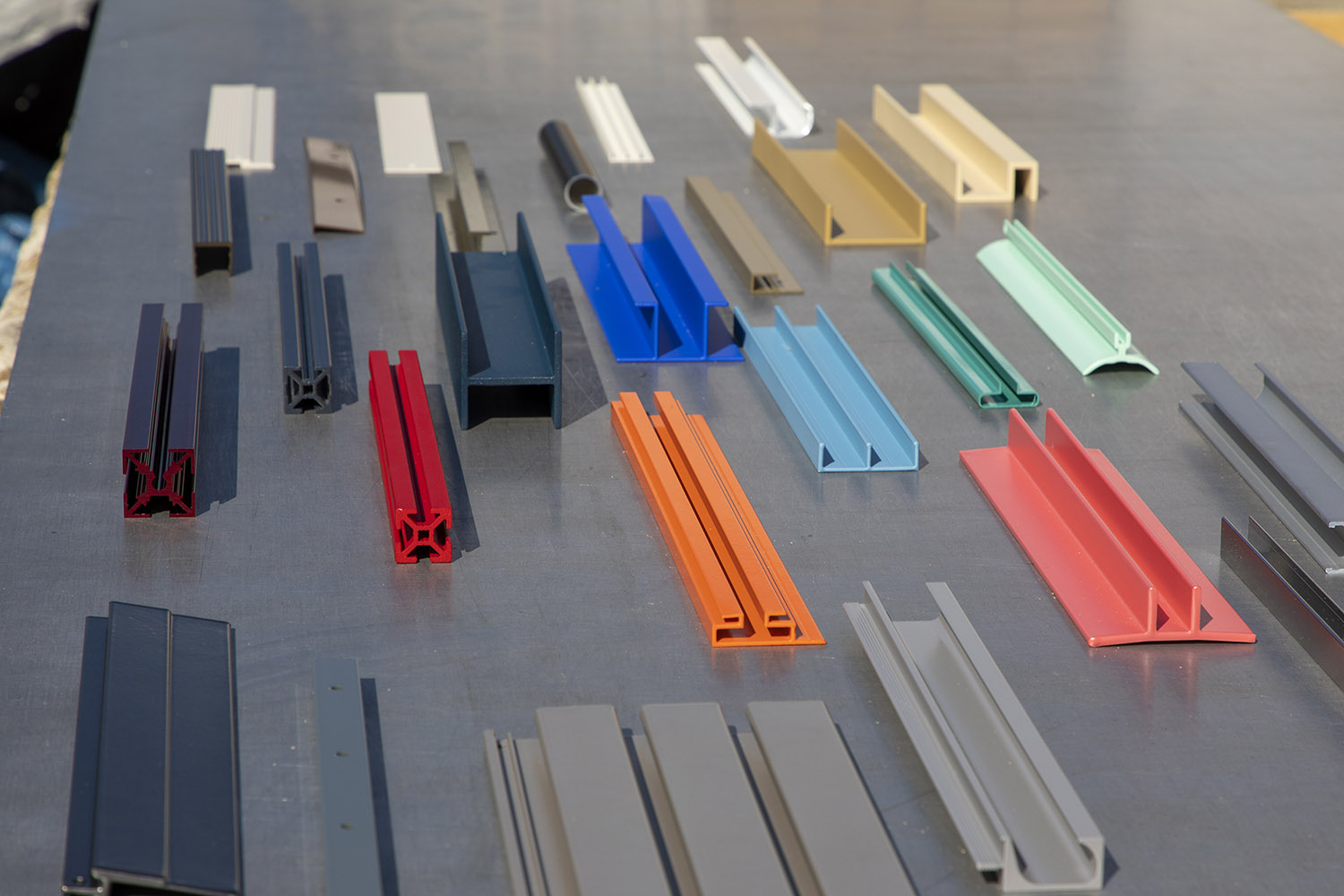Aluminum 6061 vs. 6063: Understanding the Difference

Just like there’s a tool for every project, there’s a perfect material as well. In fact, one of the major benefits of choosing from different metals for your projects is matching material and chemical properties to specific use cases.
Additionally, alloys allow similar variations of the same metal by combining additional elements.
Today, we’ll compare two of the most widely applicable aluminum alloys—aluminum 6061 vs. 6063—to help you determine which is best for your project based on their different material properties and characteristics. Both are categorized in the 6xxx series, as they contain magnesium silicon (forming a chemical compound called magnesium silicide).
6063 Aluminum Properties—The “Architectural” Alloy
Aluminum 6063 is known as the “architectural” alloy, as it is commonly used in finishing applications because it’s the most extrudable and easily anodized. Anodizing the alloy further increases corrosion resistance.
So, if the aluminum is needed for purposes that will be exposed to the elements—particularly salt and water—6063 still makes for an excellent choice. Accordingly, you can find its use in irrigation pipes and outdoor storage tanks alongside architectural designs and other exterior applications.
The elemental composition of aluminum 6063 is:
- Aluminum (Al) – 97.5-99.4%
- Chromium (Cr) – Up to 0.1%
- Copper (Cu) – Up to 0.1%
- Iron (Fe) – Up to 0.35%
- Magnesium (Mg) – 0.45-0.9%
- Manganese (Mn) – Up to 0.1%
- Silicon (Si) – 0.2–0.6%
- Titanium (Ti) – Up to 0.1%
- Zin (Zn) – Up to 0.1%
- Residual elements – Up to 0.15%
Aluminum 6063 Tensile Strength
Aluminum 6063 provides a decent tensile strength (i.e., maximum stress load), rated for up to 186, or 26,977 psi.
Aluminum 6063 Corrosion Resistance
Because it is easily anodized, aluminum alloy 6063 provides excellent corrosion resistance.
Anodization is a chemical finishing process that forcefully increases the outer layer of chemically bonded oxidation. With a thicker layer of oxidation, further corrosion struggles to eat into the majority of the aluminum.
Anodization also results in a more aesthetic appearance. It offers a uniform sheen and no surface markings for extrusion, manufacturing, shaping or handling left visible. Furthermore, anodizing aluminum allows color pigments to be added to the chemical bond, which won’t chip like paint.
For these reasons—both anti-corrosion and a high-quality finish—6063 is an alloy of choice for architectural and visible applications that will be exposed to the elements.
Aluminum 6063 Workability
Aluminum 6063 is generally considered a “softer” alloy, which lends itself toward optimal workability and extrusion forming—it’s the most common for the latter. This is because of its chemical makeup's low concentration of other elements.
One significant material property to factor in is that 6063—and all 6xxx series alloys—is heat treatable, making annealing more challenging and less repeatable when working it into complex shapes or more severe deformations.
6061 Aluminum Properties—The “Structural” Alloy
As one of the stronger and more reliable aluminum alloys, 6061 is known for its structural and load-bearing applications in construction and similar industries.
While it doesn’t anodize as well as 6063, it still provides decent corrosion resistance and is easily workable enough to be used for many extrusions.
The elemental composition of aluminum 6061 is:
- Aluminum (Al) – 95.9-98.6%
- Chromium (Cr) – 0.04-0.35%
- Copper (Cu) – 0.15-0.4%
- Iron (Fe) – Up to 0.7%
- Magnesium (Mg) – 0.8-1.2%
- Manganese (Mn) – Up to 0.15%
- Silicon (Si) – 0.4-0.8%
- Titanium (Ti) – Up to 0.15%
- Zin (Zn) – Up to 0.25%
- Residual elements – Up to 0.15%
Notably, the chemical composition breakdown shows that 6061 contains a greater amount of magnesium silicide for optimal heat treatability.
Aluminum 6061 Tensile Strength
Aluminum 6061 provides a robust tensile strength at 290 MPa, or 42,060 psi. As a result, it’s commonly found in structural applications where aluminum’s already high strength-to-weight ratio is necessary (e.g., aerospace).
Aluminum 6061 Corrosion Resistance
Although not as corrosion-resistant as 6063, the more substantial presence of chromium in 6061 provides decent corrosion protection. Once the outer surface of the aluminum begins oxidizing, the chromium will help reinforce its passivity and decrease further creep.
Aluminum 6061 Workability
Aluminum 6061 provides good workability. While it’s commonly used for extrusions, its properties are especially suited for machining and computer numerical control (CNC) purposes.
Differences in Practice: Use Cases for 6061 vs. 6063 Aluminum
As described above, alloy 6063 is more suited for architectural purposes and when corrosion resistance is an application priority. Thanks to that contrast, alloy 6061 is more found in structural and weight-bearing usages.
However, this sometimes varies due to other conditions, as 6063 has been used for bridges, and 6061 has been used for aerospace applications.
Let’s dive a little deeper into the different use cases for these alloys.
6063 Alloy: Common Applications
If the aluminum products you’re selecting will be on display or exposed to the elements, you’ll want to choose alloy 6063. The alloy’s corrosion resistance and aesthetics make it much more suited for these uses. Given its extrudability, aluminum 6063 is also widely available for all types of applications and in all kinds of shapes.
For example, aluminum pieces for retail displays and organizing are commonly made from 6063, including:
- T-slot quad tracks – Ideal for framing and structures that will be exposed to elements
- T-tracks – Ideal for adjustable positioning along the track, such as adjustable work surfaces (e.g., table saws)
- Z-clips – Ideal for panel construction, such as outdoor signs and panel walls
- Round tubes – Ideal for piping, such as water irrigation and other externally exposed fluid systems
Because of 6063’s extrudability, it’s compatible with far more shapes that require fine details, such as 90o angles and T-slot quad tracks.
Find out if aluminum or stainless steel is best for retail displays.
6061 Alloy: Common Applications
6061 is an aluminum alloy of choice if you’re using the product to bear significant weight or require guaranteed reliability and sound structures.
As a result, its extrusions are commonly found as shapes readily suited for making or adding support (e.g., legs for shelving):
Note that angle extrusions made from 6061 aluminum alloy tend to have rounded interior corners, which provide additional structural support, but make seamless constructions more difficult.
6061 vs. 6063 Aluminum: Which to Choose?
The simple answer when comparing 6063 vs 6061 aluminum properties and purposes is the former for aesthetics (“architectural”) and the latter for structures (“structural).
However, this isn't always the case.
For example, if your structural application will be exposed to excessive salt and water, it likely makes more sense to use 6063 for its better corrosion resistance and ease of anodizing. In the case of aerospace applications, 6061 provides stronger aluminum products that can better withstand increased force.
But if you’re still not sure which is the clear winner for your project, an expert can always illuminate the way to success.
Find the Right Aluminum for Your Project with Orange Aluminum
There are always project-specific considerations to account for when choosing the right aluminum alloy, and Orange Aluminum is here to simplify that choice. As a leading national supplier of extruded aluminum products offering more than 1000 SKUs, we can help find the best alloy for you—including custom options for extrusion profiles!
Get in touch with us today!



